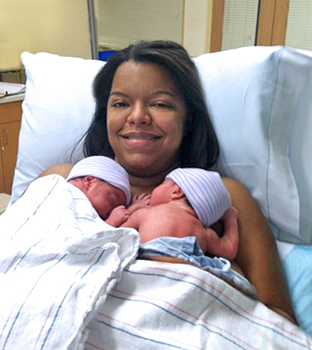Patient Stories
When envisioning giving birth, Patricia Cepeda of Lynn, always imagined she would deliver vaginally and would hold her baby’s head as he or she was brought into the world. When that wasn’t possible for her second birth, due to having a caesarean delivery for breech the first time around, she didn’t give up on her vision so easily.

The seventh grade math teacher was two weeks away from her scheduled caesarean when in the middle of the night she started to experience what she thought were Braxton Hicks contractions. Not able to ignore the pain, she went to North Shore Medical Center’s (NSMC) Birthplace at Salem Hospital. By the time she arrived she was fully dilated and was immediately prepped for an emergency caesarean.
This not being her first delivery, Cepeda knew that the best birthing plan was to take things one step at a time. The only two things she was sure of were that she would be having a C-section and that she wanted to have skin-to-skin contact with her babies immediately after birth.
“You could go in with a birthing plan but there is no guarantee that things will go as planned, especially with twins, so I didn’t want to be stringent on a birthing plan,” said Cepeda. “I was, however, adamant about doing skin-to-skin and expressed my wishes with the staff, who were happy to make it happen.”
The whole experience, from contractions to delivery, took around three hours, and shortly after delivery Cepeda was able to experience that special moment with both of her sons. Jace and Isaac Cepeda were born on August 30. Jace weighed five pounds and three ounces and was born at 4:12 a.m., while Isaac weighed five pounds and 10 ounces and was born at 4:14 a.m.
Immediate skin-to-skin contact with babies has been shown to establish a connection between mother and child sooner, which can improve breastfeeding outcomes. Having done her research, Cepeda knew that the bond needed to breastfeed could be harder to establish if you’re not able to connect with the baby from the beginning which made skin-to-skin contact that much more important to the nursing mom. Additionally, it has been shown to help premature babies grow, get out of the isolette faster, and sleep more peacefully.
“I feel this is one of those experiences where there aren’t really words to describe it,” said Cepeda. “It was just amazing to see them open their eyes a little bit and look at me while resting on my chest and then to watch my husband bond with them as well. It was the perfect family moment.”

